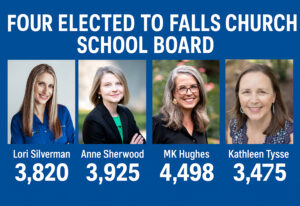At its May 5 work session, the Falls Church City Council continued refining the Fiscal Year 2026 (FY26) budget, moving closer to adopting a reduced real estate tax rate of $1.20 per $100 of assessed value, a full cent lower than the current $1.21 rate. The proposed cut comes amid a $1.2 million dip in projected revenue and aims to balance fiscal relief for residents with sustained funding for schools, city services, and capital projects.
City Manager Wyatt Shields expressed confidence in the city’s ability to meet all stakeholder needs, despite volatile markets and a challenging regional economic outlook.
“Since 2018, we’ve approved over $1 billion in commercial development,” Shields said. “Those investments are still coming online and will continue to strengthen our tax base. We are in a position to cut the tax rate and maintain high-quality services.”
Impact of the 1¢ Reduction
The revised tax rate of $1.20 would raise the average residential tax bill for a median-valued home of $1,022,400 by approximately $553—a 3.4 percent increase from FY2025. This increase reflects the rise in home values and utility fees, even as the nominal rate decreases.
The 1¢ cut will reduce expected tax revenue by $630,000, less than the original 1.5¢ cut that would have required deeper reductions on both the school and general government sides of the budget. The more moderate reduction enables a balanced approach with fewer program cuts and smaller reductions in funding for schools.
Revenue and Regional Comparison
Despite the $1.2 million revision to projected revenue, the City still anticipates a 5.3 percent increase in General Fund tax revenue over FY2025, with the majority of the growth—80 percent—driven by residential assessments, and the remainder from commercial property value increases. Real estate tax revenue alone is projected to grow by more than $5.3 million compared to the previous year.
Neighboring jurisdictions show varying approaches: Fairfax County’s adopted budget grows by 4.16 percent, Arlington by 2.2 percent, and Alexandria’s proposed budget increases by 3.2 percent. By comparison, Falls Church’s 4.5 percent increase in general government tax revenue and 4.8 percent school transfer growth positions the City competitively in the region.
Targeted Budget Reductions
To accommodate the 1¢ cut and offset lost revenue, the City proposed a series of selective expenditure reductions. Notable among them:
Elimination of the CPEDS Director position ($210,000): This role led efforts in economic development, business outreach, and regional partnerships. Its removal will require reorganization and greater involvement from the City Manager and Deputy City Manager.
Discontinuation of the Watch Night event ($35,000): Staff noted declining attendance and high vulnerability to inclement weather. Focus will shift to new events, possibly including a return of Independence Day fireworks post-construction at West End.
Reduction in training and development funding ($16,750) and elimination of a planned HR software contract ($16,250).
Ending purchase of renewable energy credits ($7,000) for City electricity, partially offset by local solar investment.
These reductions total $285,000 on the general government side. A matching $285,000 cut to the school transfer was proposed, in line with the City’s revenue-sharing policy.
Capital Investments Rebalanced
Within the Capital Improvements Plan (CIP), the City shifted priorities in response to budget pressure. Funding was removed for playground equipment upgrades at Crossman and Cavalier Trail Parks ($495,000), while $104,000 was allocated for a rooftop solar project at Aurora House, aligning with the City’s sustainability goals.
The emergency rent and food assistance fund was also increased to $25,000 (up from $6,850) to help low-income households facing rising living costs.
Employee Compensation and Inflation
Falls Church employees are slated to receive an average 5 percent salary increase, which exceeds the regional average of 3.72 percent for local governments. This pay adjustment helps the City remain competitive in a tight labor market and retain experienced staff amid increasing demand for services.
Personnel costs make up 59 percent of the general government budget, underscoring the City’s labor-intensive service model. Growth in staffing, population, and school enrollment remains modest, with average annual increases of 2 percent or less over the past decade.
Final Budget Decision on May 12
The final FY26 budget, including the tax rate and utility fees, will be voted on at the May 12 City Council meeting. If adopted, the budget will take effect July 1, 2025.
Council members signaled broad support for the more measured 1¢ cut, which they view as a compromise that offers residents meaningful relief without undermining core services or school funding.
As the City continues to leverage the long-term benefits of commercial development, its fiscal position remains stable, even amid broader economic uncertainty.












